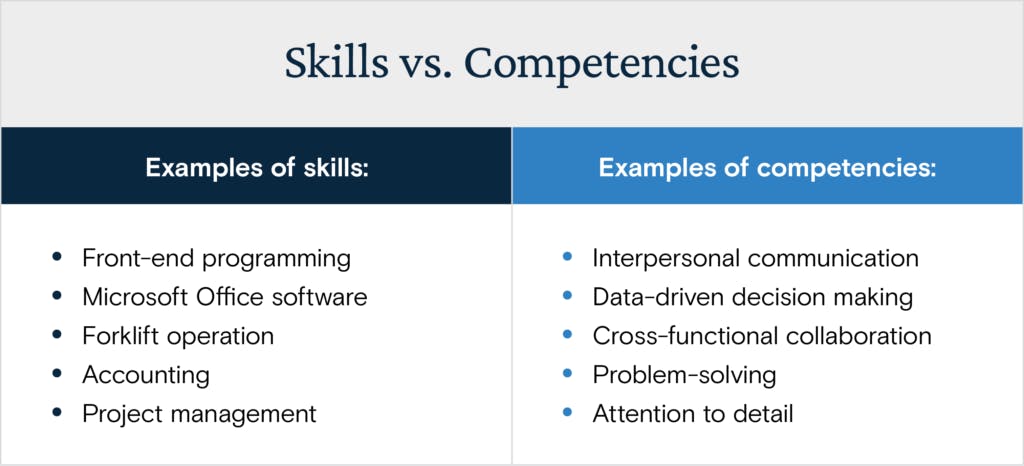An organization’s skills needs are constantly evolving – the skills required to be successful in a particular role a few years ago could be entirely different now.
To understand what skills gaps exist within your organization, as well as the learning initiatives needed to address them, you first need to be able to assess employee skills effectively.
Doing so provides valuable insight into your employees’ abilities and can serve as a strategic advantage when it comes to preparing your company for the future. This is equally true, whether assessing existing employees or prospective external candidates.
Plus, discovering what your people do well, and understanding where the critical growth opportunities exist are the first steps to creating an action plan for improving your learning and development (L&D) strategy — which, in turn, supports improved productivity and business agility.
It’s likely that your company already has an employee assessment protocol in place, but it’s important to update it regularly as technology and workplace culture evolves. Let’s dive deeper into how skills assessments can be used to inform your L&D strategy and discuss actionable tactics for improving your existing approach.
The difference between skills and competencies
First things first, why is it important to distinguish skills and competencies within employee evaluations? Though often used interchangeably, the terms have key differences that are important to be aware of.
In short, skills are one component of competencies, while competencies encompass not only skills but also abilities, knowledge and traits such as personality or work values.
So, how does that look in real life?
Skills are generally defined as concrete, learned abilities that translate across companies and occupations.
Competencies are described as behaviors, knowledge, attitudes and characteristics that make an individual better suited to a specific job. Generally, competencies take a longer time to master. You’ll often see soft skills within competencies as well.

While multiple skills can make up a competency, multiple competencies don’t form a skill.
Skills vs competencies examples
For example, let’s say you’ve got a project manager that works in the hardware manufacturing industry. They possess many of the skills needed to do the job, like a clear understanding of the manufacturing process and a mastery of project management software.
Beyond these skills, they exhibit competencies in getting team buy-in, and triangulating between the development team, the manufacturing plant and the customer.
This project manager has the skills needed to do their job and a host of competencies that would serve them well, regardless of the specific role they are in. In fact, some of these competencies specifically speak to her potential as an effective leader.
That’s why assessing both skills and competencies is especially crucial in succession planning. You’ll likely find many employees that demonstrate the requisite skills required for an advanced role, but competencies tell a fuller story that sets high-potential employees apart from their peers.These assessments allow you to identify potential leaders and top performers who have the both technical chops and hard-to-find competencies required to excel and advance within your organization.
The benefits of assessing employee skills
Skills assessments provide utility both to your business and its employees, here’s how:
Benefits for employees
By participating in skills assessments, employees are able to gain insight into their learning needs and working behaviors, which can serve to:
- Foster clarity and transparency regarding performance expectations and pathways to career growth
- Construct a more personalized employee learning experience
- Paint a clear picture of employee development progress
Benefits for your business
An established skills evaluation protocol also produces company-wide benefits that can lead to a significant positive impact across the organization. It can help to:
- Reduce bias
Merit-based promotional practices can support better diversity, equity and inclusion (DEI) across your organization. Leveraging assessment tools that are mindful of bias will encourage placements based on skills and competencies, rather than biased advancement. - Expose skills gaps
Assessments are a critical component of any skills gap analysis exercise. To truly understand where employees are lacking knowledge, you first have to be able to assess their current skill sets. Some skills gaps you know about, while others may only come to light as a result of skills gap analysis. Knowing the gaps is the first step toward addressing them.
- Provide a benchmark for consistency
Formal skills assessments provide an alternative to the more common anecdotal evaluations by management. By incorporating formal assessments into your processes, you’re capturing a constant and measurable metric for tracking the efficacy of your L&D investments. - Pinpoint needs for personal development plans
Every individual has a set of skills and competencies unique to themselves, along with areas for growth. Skills assessments allow people leaders to gain insight into those needs, informing L&D strategy in the process. - Measure progress and areas where training isn’t enough
Skills assessments help you to expose skills gaps and then determine if your existing L&D program has the learning options necessary to address those gaps. If the content you offer isn’t sufficient for addressing your employees’ skills needs, it’s time to go back to the drawing board and rethink your approach to employee education and training. - Boost employee engagement
Employees are more likely to take advantage of educational resources and upskilling opportunities if they can see progress towards a tangible career outcome. This is where regular evaluation and assessment can be a major asset in helping employees to understand their progress and be acknowledged for it. - Evolve your organization’s skills taxonomy
Your skills taxonomy gives a big-picture understanding of the skills and competencies required by your organization. Just as your company may change, expand, contract or shift course as needed, so should your skills taxonomy. Consider it a living, breathing compilation that requires regular updating to match the present direction of technology and your organization, with an eye to future needs as well. As you see the beginnings of trends in your workforce or industry, make sure the skills and competencies needed are adequately represented in your master taxonomy.
How to assess employee skills and competencies
The benefits of using employee skills and competencies assessments are palpable to both the business and employee, but the question of how to do a skills assessment that works best for your workforce remains. Let’s talk about it.
Design measurable assessments
The format your assessment takes can look a number of ways, but it should always be data-driven and designed to generate actionable information that your people-leaders can use to inform better employee programming. In general, skills can be easily assessed through direct testing, where competencies may be more anecdotal and observational.
Gather existing feedback from teams
Dive into existing data from performance reviews, including peer evaluation. Colleagues often have daily interactions and front row seats to each other's' work. Following guidelines for parity, employees can provide valuable insight on the perceived strengths, skills and competencies of their peers.
Solicit feedback from customers
Many individuals test differently in theoretical versus real-world situations. Soliciting honest feedback from your customers gives you unparalleled insight into employee performance where it matters most. Of course, this method only works for employees in customer-facing roles, but it’s still worth considering as part of your assessment strategy.
Ask customers who have recently engaged with your team members to evaluate their primary point of contact— either an individual or a team — and ask for suggestions for improvements, pain points and areas where they felt particularly well supported.
When possible, try to capture this feedback in the moment, just after an interaction. For frontline workers who regularly interact with clientele, this might involve a quick follow-up survey, allowing customers to respond while the engagement is fresh on their minds.
Administer employee self-assessments
Employee skills self-assessments can be a powerful tool for encouraging employees to look inward, evaluate their own performance and foster open discussions about their career goals and aspirations.
Collaborate directly with people managers to facilitate self-assessments and train them on how to analyze the results with their direct reports. This naturally opens the door for important discussions between managers and direct reports that can help to strategize next steps for employee development and identify key areas of opportunity for upskilling or reskilling.
Using skills assessments to inform your L&D strategy
A skilled workforce is a key contributor to the success of the company. But to enable this kind of trajectory, organizations need a clear understanding of employee strengths and weaknesses. A comprehensive skills and competencies assessment protocol is a great place to start, alongside a review of your skills taxonomy. This baseline will help define your L&D strategy and serve as a reference point for future assessments.
So, what comes next? Assessments are just one tool that help to build a future-proof workforce. Access this free resource to learn what additional actions are necessary to rapidly upskill and reskill your workforce.


